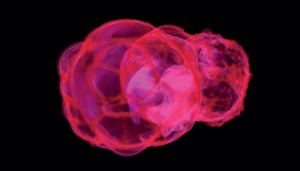Roughly 2 million years ago, as the human ancestor homo erectus was descending from the trees, two supernovae exploded nearby and showered Earth with debris.

Michael Schulreich
It’s a classic doomsday scenario. A nearby star explodes in a brilliant supernova, pumping out more energy in a split second than the Sun will emit in a billion years. The blast showers Earth with radioactive elements that destroy the ozone layer and genetically mutate life. But even though astronomers think a nearby star (that is, within 100 light-years of Earth) explodes every million years or so — although not every one has such devastating results — definitive proof has been hard to pin down.
For more than half a century, scientists have recognized two tantalizing clues that nearby supernovae might have showered the Earth roughly 2 million years ago. The first hint lies deep under the Pacific Ocean, where an isotope of iron, iron-60, is embedded within the crust. Although the Earth’s formation likely produced some iron-60, its half-life is only 2.6 million years and it would have long since disappeared. So the layers must be the result of something more recent, and nearby supernovae are the likely culprits.
The other hint is the Local Bubble — a vast peanut-shaped and plasma-filled cavity surrounding the Sun. Nearby supernova probably carved out this bubble as well.
Now Dieter Breitschwerdt (Berlin Institute of Technology) and colleagues have put these pieces together to pinpoint the likely locations of ancient supernovae. The results published April 7th in Nature, show that two supernovae, both roughly 300 light-years away, exploded 1.5 million and 2.3 million years ago.
Pinpointing Vanished Stars
To find stars that likely died millions of years ago, Breitschwerdt’s team started with their surviving family. All stars are born within clusters of hundreds to thousands of stars across a wide range of masses. A cluster’s highest-mass stars explode first, while lower-mass siblings live longer lives. So when astronomers spot a cluster made of only low-mass stars, they assume the missing high-mass stars have already gone supernovae.
After digging through archived Hipparcos data, Breitschwerdt and his colleagues found just the family they were looking for: a group of some 70 low-mass stars. The team then estimated the masses of heavyweight stars presumed missing from that cluster — which told them how long those stars would have lived — in order to pin down exactly when those stars would have exploded.
Breitschwerdt and his colleagues calculated that 16 supernovae went off like popcorn during the past 13 million years. They ran computer simulations to show how those supernovae might have carved a bubble in space — and the results perfectly matched maps of the Local Bubble.
This result alone was exciting enough. But Breitschwerdt wanted to see if he could also make the leap between this result and the iron-60 deposited on the ocean floor.
The presence of iron-60 — an isotope that’s almost exclusively created in supernova explosions — in Earth’s deep-sea crusts allowed the team to nail down a specific time-period to look for the supernovae explosions. “It's a layer that grows very slowly, which means that each successive explosion deposits new iron-60 atoms,” says Breitschwerdt. “It's like the rings in trees. If you just count the rings then you know the age of the tree.” But rather than counting tree rings, the astronomers counted iron-60 layers, and found that one layer was deposited roughly 2.2 million years ago.
It was immediately evident that two of their supernovae had occurred around that time. But in order to verify that these supernovae were the true culprits, the team first had to calculate how the iron-60 fused in the stellar core gets mixed into the blast wave that eventually hits Earth.
“It’s like if you put milk in your coffee, the milk starts to diffuse out, and then you take the spoon and stir it in order to distribute it,” says Breitschwerdt. “The supernova explosions are like spoons: they stir the iron-60 into the surrounding medium. And that has to be calculated in detail to find how long it takes to travel to Earth.”
Breitschwerdt’s calculations show that two supernovae — one that occurred 2.3 million years ago and one that occurred 1.5 million years ago — contributed roughly half of all the iron-60. The rest comes from all the other supernovae combined.
Fortuitously, another paper released in Nature by Anton Wallner (Australian National University) reports iron-60 in crust samples from four different locations in the Pacific, Atlantic, and Indian Oceans. Evidence from multiple locations is exactly what scientists expect to see, given that supernovae would have rained the isotope down across the entire globe.
Did Homo Erectus Feel the Blast?
These nearby supernovae would have occurred shortly after human ancestors descended from the trees as Homo erectus. But would these chimp-like humans have been affected by the celestial explosions?
Adrian Melott (University of Kansas) is working on that answer now. The Nature papers refer to supernovae within several hundred light-years, but supernovae have to be much closer to do any real damage, he says. “What we call the kill zone — where you get a really big mass extinction — is like 8 or 10 parsecs [26 to 33 light-years],” Melott notes.
So the effects of supernovae at several hundred light-years from Earth won’t be large. But will they be noticeable? Save for a brilliant flash in the sky, it could be that these celestial events went over our ancestors’ heads.
References:
D. Breitschwerdt et al. “The Locations of Recent Supernovae Near the Sun from Modelling 60Fe Transport.”Nature. April 7, 2016.
A. Wallner et al. “ Recent near-Earth supernovae probed by global deposition of interstellar radioactive 60Fe.”Nature. April 7, 2016.
 1
1








